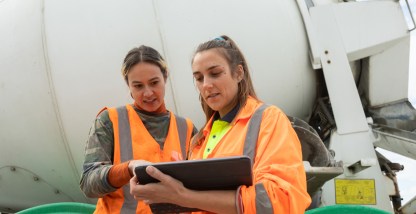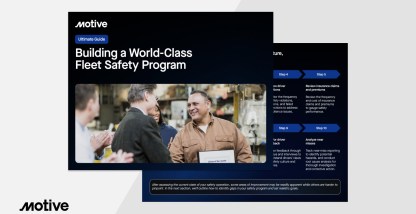As post-shutdown traffic has increased, motor vehicle deaths have risen, too. The National Safety Council (NSC) estimates that in the first six months of 2021, vehicle-related fatalities climbed 16% when compared to the same period in 2020.
For the first time since 2007, more than 42,000 people died in motor vehicle collisions in 2020. With traffic returning to more normal levels now, the high-risk habits that took root in 2020 (things like speeding, lack of seat belt use, and impaired driving) appear to be continuing unabated.
Unsafe driving habits and heavier traffic volumes can make for unsafe conditions. We’re seeing “a 16% rise in motor vehicle fatalities is not the direction we want to go in,” says NSC Statistician Manager Ken Kolosh. “Any way you slice it, the roads are not as safe right now.”
The good news for commercial drivers, according to data from the National Highway Traffic Safety Administration (NHTSA), is that deaths involving large trucks dropped 2% in 2020. So the escalation in unsafe driving isn’t a large truck problem at the source. Still, professional drivers and technicians who drive as part of their jobs must operate in this high-risk environment. The question is, what can they do to protect themselves and also improve the overall fleet risk management?
We turned to National Safety Council defensive driving expert Ryan Pietzsch for the answer. Pietzsch shares valuable defensive driving techniques for commercial drivers, construction workers, and technicians who take to the road as part of their jobs. With these six tips, workers can stay out of harm’s way.
1. Create space
“When we talk about defensive driving, we talk about leaving space,” Pietzsch says. “Space can act as a buffer and shield commercial drivers from sudden lane changes, tailgating, and other unsafe actions. The more space that is left around the vehicle, the greater a driver’s reaction time can be.”
Large commercial vehicles need additional space to allow for safe braking and responding to other drivers’ unexpected actions. The larger the vehicle, the more space that’s required. The Federal Motor Carrier Safety Administration (FMCSA) recommends leaving at least one second for every 10 feet of vehicle length. Many factors play into safe following distance, Pietzsch notes, including road conditions, speed, visibility, and the length and weight of a vehicle.
2. Be attentive
While “distracted driving” is a common problem in the transportation industry, “it’s not so much ‘distracted driving’ as ‘inattentive driving,’” Pietzsch says. Distractions such as cell phone use, the radio, and navigation tools are common, but zoning out at the wheel can be just as troublesome.
“The act of driving takes a great deal of cognition,” Pietzsch says. “It’s easy for drivers to allow their minds to wander, especially when traveling long distances or familiar routes. Both scenarios lead to complacency, and that’s when crashes and near-misses occur.”
Drivers tend to be more attentive in new environments or unfamiliar situations, Pietzsch says. Improving attention requires becoming more aware of choices made behind the wheel. This is where video-based tools such as AI-powered dashcams can help, Pietzsch says. Through real-time alerts triggered by close following and other unsafe driving behaviors, AI dashcams can interrupt complacency, correct unsafe habits, and improve performance.
“For people unable to make cognitive interference on their own, dashcams can be great tools for coaching them,” Pietzsch says.
3. Use safety technology to document the unsafe actions of others
Dashcams can also be used to help commercial drivers defend themselves from the aggressive actions of others. For example, if a driver cuts them off or jockeys for space, they can hit the manual button on the dashcam to record the behavior and show they acted responsibly.
4. Reflect, reframe, refocus
When dealing with aggressive drivers who are speeding, tailgating, or weaving, it’s human nature to want to react. But when an aggressive driver comes into view, it’s all the more critical for commercial drivers to exercise patience.“The first step is to reflect on the situation unfolding,” Pietzsch says. “Commercial drivers can take the time to ask, ‘’How will reacting help me arrive at my destination safely?’ In stressful moments, it’s crucial to stay focused so the situation doesn’t escalate.”
The second step is to reframe the situation. When encountering the unsafe actions of others, we can’t know what’s motivating them, Pietzsch says. They may be rushing to the hospital, they may be impaired, or they may be getting away from a high-risk situation themselves.
“Commercial drivers can slow down, breathe, and understand that this small moment in time will pass,” Pietzsch says. “Responding in a responsible way, such as pulling over and letting a tailgater by, can help de-escalate unsafe interactions on the road.”
Then, by refocusing their attention on safe driving, commercial drivers can achieve the ultimate goal — arriving at the destination safely.
5. Buckle up
An easy way for workers to protect themselves from road risks is to wear a seat belt every time they step into a vehicle. NHTSA data show that fatalities where drivers and passengers weren’t restrained rose 15% from 2019 to 2020. The lack of seat belt use likely contributed to a 20% rise in occupant ejections in 2020. “Wearing a seat belt is one of the easiest methods of saving lives on U.S. roadways,” Pietzsch says.
6. Recognize signs of impairment
According to NHTSA data, alcohol-related fatalities rose 9% in 2020, up to 7,324 from 6,704 in 2019. Safety managers can educate workers on how to spot signs of impairment to better avoid encounters with drivers under the influence. Often, impaired drivers weave within their lane and exhibit erratic fluctuations in speed.
Should an impaired driver cross your employee’s path, “it comes back to creating space around the vehicle,” Pietzsch says. “Keeping the impaired driver out in front allows commercial drivers to choose proper speed and following distance to help avoid them.”
Once an impaired driver is behind you, you limit your ability to safely maintain space, opening yourself up to being rear-ended. If an impaired driver is approaching from behind, commercial drivers can pull over to get out of the driver’s path, or even exit the highway for a few minutes before getting back on.
Want more safety insights? Our new AI-powered safety platform can transform the safety of your operations. See how it can help your fleet reduce accidents by up to 30%.









